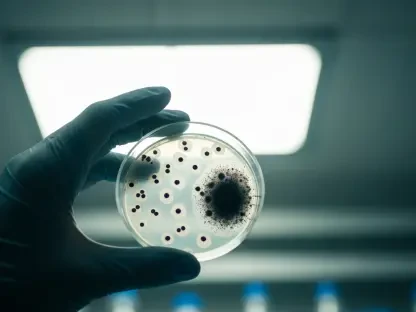In the rapidly changing landscape of global security, the biodefense industry stands as a critical player, responding to increased threats of bioterrorism and infectious diseases. Governments worldwide are ramping up investments and developing policies to enhance emergency preparedness and strengthen infrastructure against biological threats. With projections indicating the biodefense market’s expansion to a staggering $24.6 billion by 2032, this sector is quickly becoming a cornerstone in health security frameworks. The anticipated compound annual growth rate (CAGR) of 6.24% speaks to the industry’s substantial potential, driven by advancements in technology, heightened demand for preemptive strategies, and transformative shifts in global health policy. As new threats emerge, the role of biodefense evolves, underscoring vital measures for safeguarding communities on a global scale.
The Emerging Role of Biodefense
At the heart of the biodefense narrative is an imperative need to protect populations against bioterrorism and pandemics through proactive and responsive measures. The threats from rogue states and non-state actors are prompting governments to bolster their defense mechanisms and readiness. To address these threats effectively, countries are increasingly investing in biodefense infrastructure, spanning policy reforms, funding allocations, and public health mechanisms. This surge in governmental support not only reflects a growing acknowledgment of biological threats but also predicates a widespread urgency to build resilient systems capable of rapid response. Biodefense is setting the stage for a robust network that integrates various domains of security, weaving together technological innovations, healthcare responses, and strategic collaborations to fortify global health security.
Recognizing these challenges, governments have embarked on multiple initiatives targeting the advancement of biodefense capabilities. Key efforts focus on strengthening surveillance systems, setting up emergency coordination centers, and fostering international cooperation. Governments are exemplifying strategic foresight by instituting programs geared towards cross-border partnerships, thereby paving the way for global initiatives to counter biological threats. Additionally, interdisciplinary collaborations between research institutions and military organizations further enhance capabilities and readiness. Such multidimensional strategies are vital in combating threats efficiently and underscore biodefense’s evolving role in the realm of global health security. These preparations are crucial for minimizing impact—not only on national scales but also reinforcing collective international defense strategies.
Technological Advancements in Biodefense
A significant facet of the evolving biodefense market is the technological innovation that underpins pathogen detection and vaccine development. Cutting-edge discoveries in vaccines such as mRNA and protein subunits are revolutionizing biodefense strategies, offering quicker and more effective responses to infectious disease threats. Viral vectors introduce promising pathways for creating robust vaccines, attuned to quickly adapt to emerging pathogens. The amalgamation of biosensors and PCR-based devices provides a nuanced and comprehensive approach to pathogen detection, elevating the precision and speed of identifying threats. Integrated AI-based surveillance systems are dramatically enhancing early detection capabilities, enabling timely interventions that mitigate risks to populations. These technological advancements are crucial for devising comprehensive disease management strategies, with an emphasis on preparedness and rapid response.
Technological strides form the backbone of the biodefense sector’s dynamic landscape. The improved diagnostic tools, innovative platforms, and intelligent analytics offer a multifaceted approach to threat detection and disease mitigation. As the sector breaks new ground, advancements in digital technologies illustrate the transformative potential within the realm of biodefense. These systems, equipped with AI, big data, and cloud computing, are streamlining biosurveillance practices, rhythmically orchestrating information flow from detection to reaction. By capitalizing on the confluence of scientific discovery and technological prowess, health security is advancing beyond conventional boundaries, reflecting a future where digital innovation stands at the forefront of biodefense strategies. This integration facilitates prompt adaptation to new challenges, priming responses to a myriad of biological threats.
Biodefense Market Segmentation and Influence
The biodefense sector not only invites analysis of technological innovations but also requires a comprehensive overview of market segmentation and its long-term impacts. Key segments include bioterrorism preparedness, disease management, research & development, and pharmaceutical manufacturing. Different areas of application allow for the diversification of opportunities geared toward bolstering biodefense mechanisms. The primary end-users—government agencies, healthcare institutions, research entities, and military organizations—demonstrate a vested interest, leveraging market advancements to fortify defense capabilities. Biodefense developments thus resonate across various sectors, facilitating product innovation that stems from strategic public-private collaboration and enhanced interdisciplinary partnerships. These elements reflect a multifaceted market landscape, cultivated through innovation-driven outcomes targeted at safeguarding communities against biological threats.
Regionally, North America emerges as a trailblazer, endowed with leading biotechnology firms, influential government programs, and pivotal funding initiatives. U.S. agencies such as the Biomedical Advanced Research and Development Authority (BARDA) and the Department of Homeland Security champion substantial investments in research and development. Europe, buoyed by EU initiatives, is harnessing cross-border preparedness to solidify its biodefense stance, with robust funding and collaborations reinforcing security efforts. Meanwhile, Asia-Pacific is witnessing significant advancements backed by extensive investments, particularly in emerging economies such as China, India, and Japan. These regions collectively contribute to a thriving biodefense market, characterizing a diverse global landscape influenced by concerted efforts across geopolitical spectrums. This dispersion accentuates the pivotal role of regional collaborations in worldwide health security.
Industry Leaders and Trends
As the biodefense market advances, key players in the industry such as Roche, Pfizer, Moderna, and Merck are central to pioneering developments in diagnostics and vaccine platforms. These companies are setting benchmarks with their contributions, emphasizing innovative solutions pivotal for threat mitigation. Their expertise in mRNA vaccines, biologics, and functional diagnostic tools evidences a seamless integration of technical excellence with practical applications. Collective endeavors by these entities encapsulate the competitive spirit shaping the market’s dynamics, wherein continuous investments in research and strategic collaborations steer progress. The momentum, illustrated by emergent trends, exemplifies a synchronized approach to biosurveillance and risk assessment, leveraging forward-thinking ideas to counter future threats effectively.
Strategic formations are driving innovations beyond traditional boundaries, with public-private partnerships thriving amid technological advancements. Procurement contracts for infrastructure stockpiling and alliances with government bodies furnish the sector with vital resources that propel market growth. Companies today keenly deploy AI and machine learning capabilities, highlighting the significance of advanced analytics in refining product offerings and responding to complex threats. This reliance on digital tools foregrounds the importance of cloud-based epidemiological platforms and AI-enhanced alert systems, representing the sector’s intrinsic shift towards digitalization. With industry leaders maintaining a competitive edge, new trends unfold, illustrating a trajectory paved with technological advancements and strategic unity within the domain of biodefense.
Future Outlook and Strategic Actions
Central to the biodefense narrative is the compelling necessity to shield populations from the dangers posed by bioterrorism and pandemics, employing both preemptive and reactive strategies. Threats from rogue nations and non-state actors are driving governments to enhance their preparedness. To effectively confront these challenges, countries are channeling investments into biodefense infrastructure, which includes policy reforms, financial resources, and public health mechanisms. This increase in governmental backing mirrors the escalating recognition of biological threats and the pressing need to build robust systems for swift action. Biodefense is laying down a comprehensive framework that connects various security domains, uniting technological advances, medical responses, and strategic alliances to strengthen global health security.
Governments are responding by initiating various programs aimed at improving biodefense capabilities. Important efforts include enhancing surveillance systems, establishing emergency coordination centers, and promoting international collaboration. Demonstrating strategic insight, governments are launching initiatives that encourage cross-border partnerships, which are vital to global efforts against biological dangers. Further, interdisciplinary partnerships between research institutes and military bodies boost readiness and capacity. These multifaceted strategies are crucial in effectively addressing threats, reinforcing biodefense as a key factor in global health security, and ensuring readiness on both national and international fronts.









